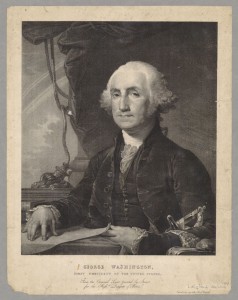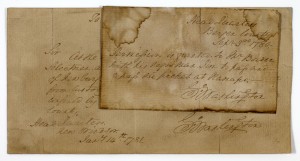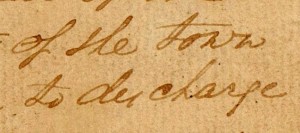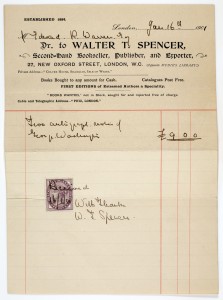
We are kicking off Fraud Week on Past is Present with a big one: forgeries of George Washington’s handwriting. The choice of subject is particularly apropos since today is Washington’s birthday and, not surprisingly, the American Antiquarian Society has many Washington-related items, including:
- over 2,600 books, pamphlets, periodicals, and graphics related to George Washington listed in our online catalog
- an interesting discussion of Washington’s personal library
AAS has only a small manuscript collection of George Washington Papers, though, and two of the most interesting items in that manuscript collection were actually not written by George Washington. They are forgeries, created by the most famous forger of Washington’s handwriting, Robert Spring.
Who was Robert Spring?
While nowhere near as well-known as the president whose signature he copied, Washington’s most famous forger was something of a notorious celebrity in his own right. Robert Spring even merited an entry in Appleton’s Cyclopedia of American Biography, making him the “only rogue — at least so labeled — in that six-volume work,” according Thomas Madigan’s book on autographs, Word Shadows of the Great. Robert Spring’s rise (or rather, slide) to infamy is outlined in a newspaper article that originated in the Philadelphia Press and was picked up by The Trenton Evening Times on October 30, 1885.
According to the newspaper account published years after his death (apparently Spring was considered sensational news even posthumously!), Robert Spring was born in England in 1813 but moved to America in his youth:
He was industrious and pushing, and when about 23 years old, started on a tour as a book-peddler, selling “Binns Justice” a work just published and in great demand. Spring was in those days comparatively honest, and he traveled on horseback through Pennsylvania, Virginia, the Carolinas, Georgia, Kentucky and Tennessee meeting with great success in selling his books to justices and lawyers. It was while on this long tour that he became acquainted with a new business, the purchase and sale of rare books and autographs.
Spring’s early work as a book peddler not only gave him insider knowledge of the book and autograph market, but also may have helped him develop his own “confidence man” sales techniques that he later would use to pass off faked Washington letters.
What pushed Spring, a “comparatively honest” if “pushing” young man, into a life of crime?
The surprising answer is a cartload of foolscap (i.e. letter-sized) waste paper and an old-fashioned washstand. As the newspaper account of Spring’s descent into a life of crime recounts it, the turning point in Spring’s life came in 1855:
At a sale in Baltimore of the accumulated paper of an old banking house, Spring bought a cartload of waste paper. In it he found a fortune in the shape of a quantity of checks of General Washington on the Alexandria bank… and also a large amount of blank foolscap, of English manufacture, such as was used in this country until after the revolution. … Had it not been for the suggestive presence of the old foolscap, possibly Spring would have been contented with their [i.e. the genuine Washington articles] legitimate sale.
At first Spring was content to sell the original checks and other business papers with Washington’s signature, but when these ran out, he began to forge Washington’s handwriting.
How did Spring actually create his forgeries?
Here is where the newspaper account of Spring’s life becomes so detailed it reads almost like a how-to guide to forgery:
Every one has seen the old-fashioned washstand, with a round hole in the top, in which the washbowl was placed. Spring took such a stand, placed a pane of glass over the hole, over this a genuine Washington signature, and over this a sheet of blank paper. Then beneath the glass he placed a lamp and darkened the room. Thus the signature was illuminated from beneath and could easily be traced on the blank paper. … He easily stained the paper to the color of age, and would crease it and give it a worn edge by wearing it between this stocking and the sole of his shoe.
Upon first read this account, I wondered: why Spring would have to stain the paper to age it? After all, one of the reasons he even began this life of crime was the tempting possibilities of reams of old foolscap contemporaneous with the genuine Washington artifacts. Yet unused paper that has been stored away from light and air will age quite differently than paper that has been out-and-about in circulation, so it makes sense Spring would have to “rough up” his paper supply, even if it was the right age.

The stained paper was one of the first things that stood out as odd when I first examined the two Spring forgeries at AAS in person. It’s hard to describe exactly what seemed wrong with it: the staining is almost too perfectly irregular, perhaps? The best way I can put it is that it reminded me of an elementary school history project for which I had to write a letter pretending to be from the eighteenth-century. I soaked my letter in tea in an attempt to make it look more authentic, although mine turned out a little spotty. Did Spring resort to this same tea-staining method to artificially age his forgeries? Were the examples that survive at AAS done on the original Revolutionary-War era foolscap that Spring purchased, or had his supply run out forcing him to substitute later 19th-century paper and more tea to achieve the effect? Perhaps these are questions for the History Detectives!
How do we know the Washington documents at AAS are forgeries?
Even without being able to closely examine or test the paper and ink, there are a number of ways to tell that these two purported Washington documents are fake once you know where to look. So here’s a crash-course in detecting Washington forgeries. (Just for fun, you may want to try to figure out which is the forgery and which is really Washington’s signature below before continuing to read; the images have been grayed out so you can try to focus on the pen strokes rather than variations in the paper and color.)


Looking at the signatures, focus on the “G” in particular. The most obvious difference is that the real George Washington always signed his name “Go:” with the “o” as a superscript and two dots under it; for some reason, Spring would only put one dot.


In the close-ups of the text of the documents, notice how the real Washington’s handwriting is round and loopy, whereas in the forgery it is tighter and more perfectly angled. For instance, if you carefully examine the letter “h” in the word “the” in each close-up you will notice the real Washington’s handwriting has a very round loop at the top while in the forgery it is much narrower and looks more like a penmanship book.
Now that we have assured ourselves that these two documents are indeed forgeries, how do we determine that they were done by Spring?
In this case, Spring made it easy for himself and for us: he recycled only a few scripts over and over. The documents at AAS follow two of Spring’s most common scripts line-by-line, as described by the editors of the George Washington Papers in an excellent article written by Dorothy Twohig, “George Washington: Forgeries and Facsimile.” The most common script reads as follows:
To Jabez Huntington Esqr.
Sheriff of the County of Windham, Connt.
At the urgent solicitation of several of the Selectmen and respectable inhabitants of the town of Poughkeepsie, I hereby authorize you to discharge from custody Daniel Elliott now a prisoner and confined by Military Warrant to the Gaol of sd. County.
Go: Washington
Head Quarters
New Windsor
Jany 14th 1781
The name of the prisoner and the date vary with each document, but the script is otherwise exactly the same. Similarly, in the other most common Spring forgery, the names may change, but the story stays the same:
Head Quarters
Valley Forge
Feby 5th 1778
Permission is granted to Mr. John Edwards with his Negro boy Jack to pass and repass this picket at Ramapo.
Go: Washington
In her article on Washington forgeries, Dorothy Twohig explains why Spring used so many different names:
The Papers of George Washington staff has acquired innumerable copies of this pass issued to Mr. Johnson and Sam, to Mr. Smith and Tim, to Mr. Carson and Henry, and so on… Since none of the passes unearthed so far bears the same name, it is evident that Spring changed the names on the document each time he encountered an affluent victim, simply making out a pass to order.
Spring’s penchant for repetition led the witty Thomas Madigan, whose book on autographs titled Word Shadows of the Great was mentioned earlier, to speculate:
Heaven knows how many times the indefatigable Spring caused “Mr. Ryerson and his negro man, Dick,” to pass the picket at Ramapo — so often, I am sure, that the two might have constituted the first important traffic jam in American history.
Spring’s lack of imagination finally caught up with him, though. He was arrested in Philadelphia 1869, spent years in prison, and died in poverty 1878 — an appropriately moral ending to his story of fraud and forgery, all sparked by the “suggestive presence of the old foolscap.”
What about the afterlife of Spring’s handiwork? How did his forgeries end up at AAS?
The good news is, we weren’t duped into purchasing the Spring forgeries. The bad news is, someone else was.
By the turn of the twentieth century, our two “Washington” documents had found their way to a London bookshop of Walter T. Spencer. In a fascinating twist, this bookseller wrote a memoir titled Forty Years in My Bookshop and he claims at the very end of that book that at about the turn of the century he had been offered forged documents, including Washington’s signature! In his book, the bookseller claims he was smart enough to refuse them:
Fifteen or twenty years ago I had offered to me from time to time several letters and short manuscripts alleged to be in the autograph of great men, Thackeray and George Washington among them. .. I am glad to be able to recall I had sufficient knowledge of my business to pronounce them forgeries. (279-280)

Apparently, at least these two forgeries by Spring got past the bookseller’s expert detecting skills, because he sold them as the genuine to a Mr. Edward R. Warren on January 16, 1901 for €9. (According to the site Measuring Worth this would be approximately $1,000 in today’s money.) Just imagine how Mr. Warren felt when he found out the documents he bought were forgeries!
Unfortunately, no letter from Mr. Warren explaining why he gave us these documents survives in the AAS archives. There is a note on the envelope they came in that states the forged documents were the gift of Mr. Edward R. Warren, Dec. 18, 1934, along with the “original bill from the English dealer who sold the two documents as genuine.” Perhaps Mr. Warren could no longer bear having to look at them once he realized he had been duped. We certainly are glad he gave the documents to AAS rather than throwing them into a therapeutic bonfire. In my opinion at least, the story of the fakes is much more interesting than if we really had a letter from Washington allowing passage through that fictionally well-traveled picket at Ramapo.
Further Reading:
Madigan, Thomas. Word Shadows of the Great. (New York, 1930)
Spencer, Walter T. Forty Years in My Bookshop. (Boston, 1923)
Twohig, Dorothy. “George Washington: Forgeries and Facsimile.” Originally appeared in The Journal of the Society of Georgia Archivists (Spring 1983, vol. 1, pp. 1-13).
And finally, if you’ve had enough of the forgeries and want to read some of Washington’s real writing, check out The Papers of George Washington, or visit a new website debuting today which includes transcriptions of many of Washington’s writings, First in Peace.

One thought on “Fraud Week, Part 2: Will the Real George Washington Please Sign Here?”